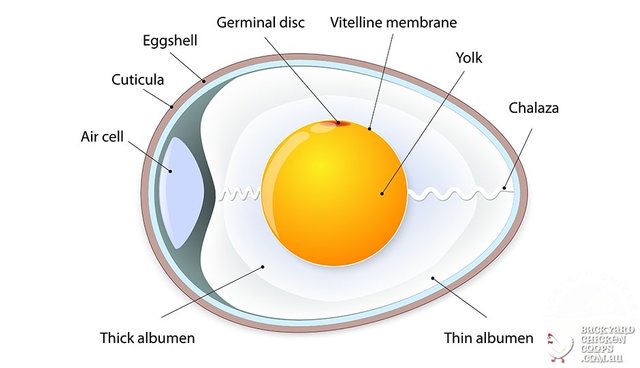What is an Egg?
A chicken egg can be either fertilized or unfertilized, and is the perfect little package (an average-sized egg weighs about 50 grams, however this will vary depending on the chicken breed), comprised of seven basic parts; the shell, membranes, the albumen (white), the yolk, the chalazae, the germinal disc and the air sac. Each of these parts have a particular job to do and serve a certain purpose.
infographic-about-egg-anatomy
Shell: The eggshell is a very fascinating piece of engineering, housing the entirety of the eggs components within it. It is made up almost entirely of calcium carbonate, and covered in tiny pores, which give the egg it’s grainy texture. The shell is a semipermeable membrane, which is just fancy talk for meaning that air and moisture can pass through it’s pores. It is also protected by a thin outermost coating known as the ‘bloom’ or ‘cuticle’, that acts as a natural barrier against external pathogens such as bacteria and dust.
Membranes: The egg has two membranes-outer shell membrane and inner shell membrane, which both sit just inside the shell enclosing the albumen (white). These super strong transparent protein membranes, which are made partly of keratin, have the job of protecting against bacterial invasion. The outer membrane is secured to the egg shell, while the inner membrane sticks to the albumen.
Albumen (White): The albumen, more commonly known as the ‘white’, is made up of vitamins, protein, minerals and water and consists of three main parts-an inner, middle and outer layer, each of varying thickness that surround and protect the yolk. These powerful layers contain an abundance of proteins that in a fertile egg will help with the chicks development, or if infertile, will be passed on to us!
The Yolk: The yolk is the central part of an egg, and while usually yellow, its colour can vary depending on the chicken breed, ranging from a light yellow to a deep orange. This little powerhouse is where most of the proteins, minerals, fats and vitamins of the egg are housed, including Vitamin A, D, phosphorous, calcium, thiamine and riboflavin.
Chalazae: Chalazae are part of the egg white and are strings of twisted tissue positioned at opposite ends of the yolk. They play the important role of stabilising the yolk and germinal disc to prevent twisting and misalignment in the egg.
Germinal Disc: Also called the egg cell, or blastodisc, the germinal disc sits on the surface of the top of the egg yolk and is the ‘powerhouse’ of the egg, as it is where the sperm enters the egg. It is here that the embryo will form by a process of cell division and growth once fertilisation has taken place.
Air Sac: Sometimes known as the ‘air space’ or ‘air cell’, the air sac forms when the contents of a freshly laid egg cools, causing them to contract. This air sac rests between the outer and inner membranes at the eggs larger end. As the egg matures, regardless of fertility, the air sac will expand due to moisture and carbon dioxide leaving the egg, and air entering the egg to replace them.